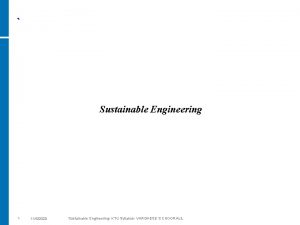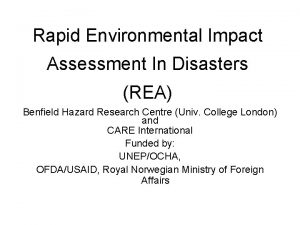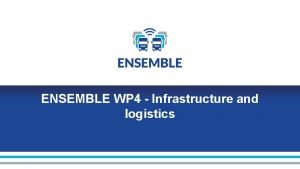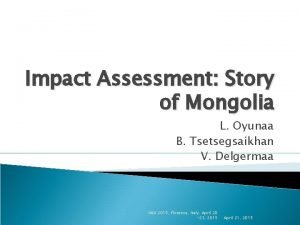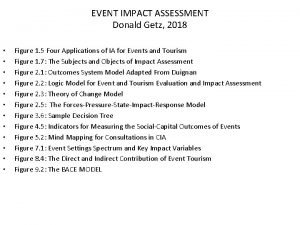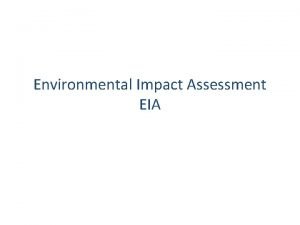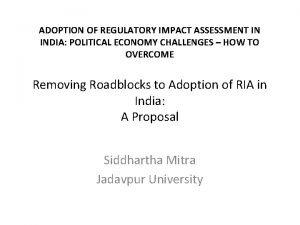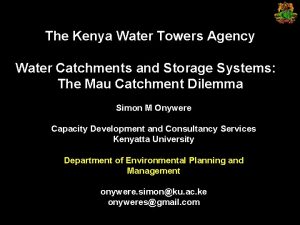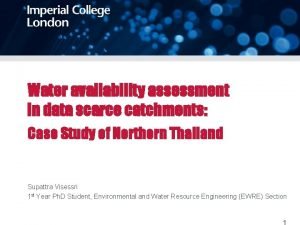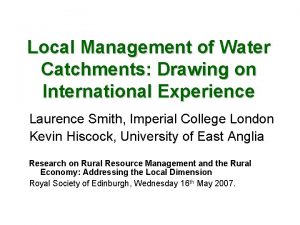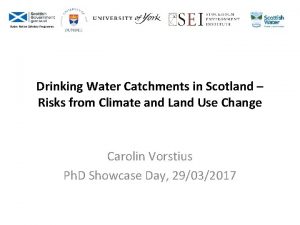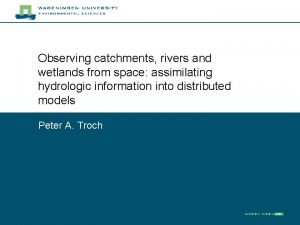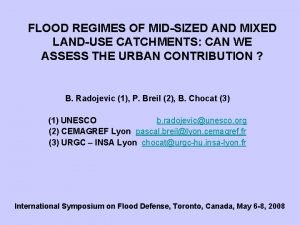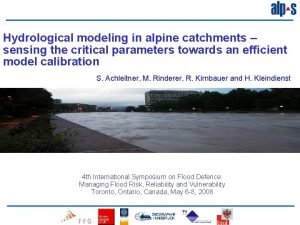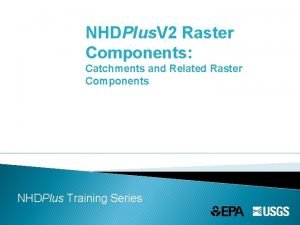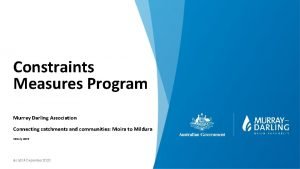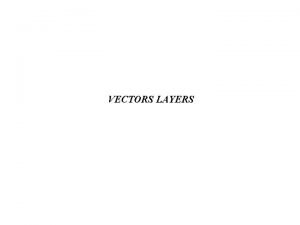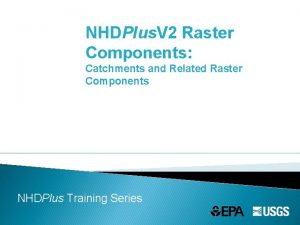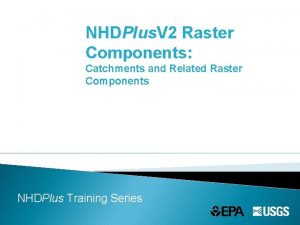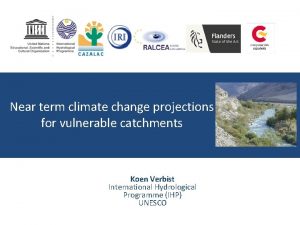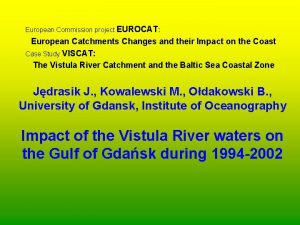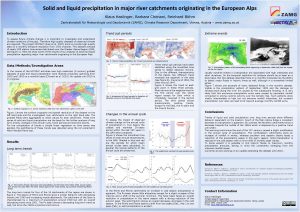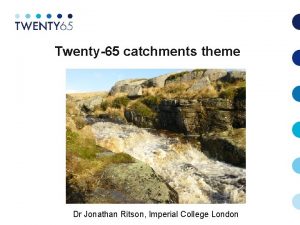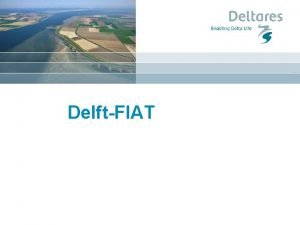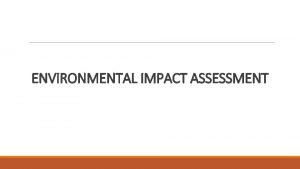Assessment Of The Impact Of Catchments Providing Water















































- Slides: 47

Assessment Of The Impact Of Catchments Providing Water To Marj Sanour & Design Of Water Collection System (Hydrologic Analysis) By: Isam Khasib Supervisor: Farouq Hamad Bashar Ibrahim Eng. Hamees Tubeileh

Outline: Ø Geography and Topography. Ø Challenges & Solutions. Ø Hydrology parameters calculations. Ø Flows & volumes results. Ø American & Tubas patterns. Ø Suggested Activities and projects. Ø Projects Evaluation. Ø Design of storm collection system.

Study Area ØGeography and Topography

Geography and Topography Ø The Marj Sanour watershed forms a unique closed watershed area in the West Bank. The total area of the watershed is about 58. 58 km². Ø The Marj watershed area has an almost rectangular shape with northwest-southeast elongation. Ø The lake region is located between 350 and 375 contour lines above sea level.



Methodology: GIS model Allocation of catchments Soil type and texture Daily rainfall data Frequency analysis (rainfall V. S. return period) HEC-HMS model Curve number determination Hydrographs

Methodology: allocation of catchments using GIS-Software �Allocation of catchments

Methodology: �Rainfall data collection: Rainfall data were collected from Arraba, Qabatia, Maythaloon & Raba stations from 2008 to 2016. �Correcting missing data using Normal Ratio method

Methodology: �Frequency analysis using corrected rainfall data for Maythaloon station. �We have chosen the highest daily rainfall in each year. Year 2008 Precipitation (mm) 66 2009 65 2010 83. 5 2011 60 2012 89. 5 2013 79 2014 70 2015 48 2016 58. 5

Methodology: �Probability of exceedance using Weibull distribution. Year Precipitation (mm) Ranking (m) Probability Return period 2008 66 6 0. 60 1. 67 2009 65 5 0. 50 2. 00 2010 83. 5 2 0. 20 5. 00 2011 60 7 0. 70 1. 43 2012 89. 5 1 0. 10 10. 00 2013 79 3 0. 30 3. 33 2014 70 4 0. 40 2. 50 2015 48 9 0. 90 1. 11 2016 58. 5 8 0. 80 1. 25

Methodology: 100 �Precipitation against return period 90 80 60 50 40 precepitation 70 30 20 10 25, 00 Return period 5, 00 0 1, 00

Methodology: �Catchments parameters: SCS-Curve number, slope, length of main streams & lag time. �Starting with CN, four hydrologic soil groups: I. III. IV. Group A Group B Group C Group D

Methodology: �In Marj Sanour we have three soil types and these are : 1) Brown Rendzinas and Pale Renzinas. 2) Grumusols. 3) Terra Rossas, Brown Rendzinas and Pale Rendzinas.

Methodology: � I. III. Soil moisture conditions are three types: Condition I: soils are dry Condition II: average (normal) conditions Condition III: saturated (wet) soils

Methodology: �CN II is considered the base CN.

Methodology: �Shadeed and Almasri (2010) have shown the antecedent moisture condition based on five days of rainfall precede the design storm

Methodology: �Also, Shadeed and Almasri (2010) could classify the soil type and soil texture into type A, B, C or D soil.

Methodology: �We can consider Marj Sanour soils as follows: ü Grumusols: Type D ü Terra Rossas, Brown Rendzinas And Pale Rendzinas: Type D ü Brown Rendzinas And Pale Renzinas: Type C

Methodology: �Land uses in the Marj are indicated as follows: ü Olive Groves ü Natural Grass Land ü Non Irrigated Arable Land ü Agricultural Land With Natural Vegetation ü Discontinuous Urban Fabric ü Military Camps

Methodology:

Methodology:

Methodology: catchment No. Length of main streams in Km S% Length in ft CN 2 CN 3 Lag time (min) 0 2. 71 20. 05 8891. 08 84. 00 92. 40 81. 62 1 2. 03 19. 5 6660. 10 84. 50 92. 60 65. 10 2 3. 7 13. 71 12139. 11 82. 20 91. 40 132. 34 3 0. 82 6. 16 2690. 29 78. 70 89. 50 64. 01 4 2. 33 4. 71 7644. 36 77. 50 88. 80 173. 56 5 2. 94 12. 72 9645. 67 80. 10 90. 30 119. 75 6 1. 45 10. 78 4757. 22 78. 50 89. 40 76. 65 7 1. 44 7. 03 4724. 41 81. 40 90. 90 88. 74 8 0. 73 11. 3 2395. 01 83. 30 92. 00 38. 76 9 1. 63 12. 8 5347. 77 84. 70 92. 70 67. 10 10 0. 58 14. 2 1902. 89 83. 70 92. 20 28. 51 11 0. 75 17. 22 2460. 63 84. 00 92. 30 31. 66 12 0. 55 9. 66 1804. 46 79. 10 89. 70 36. 84

Methodology: catchment No. Length of main streams in Km S% Length in ft CN 2 CN 3 Lag time (min) 12 0. 55 9. 66 1804. 46 79. 10 89. 70 36. 84 13 0. 49 24. 21 1607. 61 84. 30 92. 50 18. 82 14 0. 76 19. 35 2493. 44 80. 90 90. 70 32. 35 15 2. 09 18. 76 6856. 96 73. 10 86. 22 87. 86 16 1. 21 14. 69 3969. 82 69. 50 83. 97 69. 40 17 0. 96 16. 82 3149. 61 71. 90 85. 46 51. 17 18 1. 01 22. 07 3313. 65 84. 70 92. 74 34. 78 19 0. 55 18. 93 1804. 46 79. 20 89. 78 26. 23 20 0. 97 18. 15 3182. 41 78. 40 89. 31 42. 98 21 2. 61 3. 89 8562. 99 78. 70 89. 47 203. 64 22 2. 46 10. 7 8070. 87 80. 80 90. 66 111. 52 23 0. 4 18. 93 1312. 34 71. 10 84. 97 24. 36 24 1. 86 19. 16 6102. 36 83. 60 92. 15 62. 48

Methodology: �lag time in each catchment was calculated using SCS-lag equation because we will be using it in HEC-HMS software.

Results & calculations: �the HEC-HMS software to complete the hydrologic analysis and find the hydrographs.

catchment # Peak flow(m³/s) Volume(m³) 0 11 84. 49 1 7. 7 85. 01 2 11. 2 81. 89 3 2 77. 08 4 4. 3 75. 35 5 14. 2 79. 08 6 3. 5 76. 83 7 4. 7 80. 6 8 2. 1 83. 44 9 8. 1 85. 28 10 1. 7 83. 96 11 1. 9 84. 22 12 0. 5 77. 58 13 0. 9 84. 75 14 1. 4 80. 09 15 8 69. 19 16 2. 7 88. 67

Peak Flow in each catchment 18 15, 4 16 14, 2 14 Peak flow (m³/s) 12 11, 5 11, 2 11 10 8, 1 7, 7 8 8, 1 8 6 4, 7 4, 3 4, 5 3, 5 4 2, 1 2 2 2, 7 1, 9 0, 5 0, 9 2, 5 1, 4 1, 1 0, 9 0 1 2 3 4 5 6 7 8 9 10 11 12 13 14 15 16 17 18 19 20 21 22 23 24 25

Volume in each catchment 100 90 88, 67 84, 49 85, 01 81, 89 79, 08 77, 08 76, 83 75, 35 80 80, 6 85, 28 83, 96 84, 22 83, 44 85, 38 84, 75 80, 09 77, 58 79, 99 76, 6176, 98 69, 19 70 67, 43 66, 31 60 Volume (m³) 83, 83 55, 06 50 40 30 20 10 0 1 2 3 4 5 6 7 8 9 10 11 12 13 14 15 16 17 18 19 20 21 22 23 24 25

0, 20 0, 19 0, 18 0, 16 0, 15 0, 14 hourly factor 0, 12 0, 097 0, 10 0, 08 0, 06 0, 08 0, 07 0, 06 0, 05 0, 04 0, 03 0, 04 0, 02 1 2 3 4 5 6 7 8 0, 02 0, 01 0, 003 0, 01 0, 000, 00 0, 03 9 10 11 12 13 14 15 16 17 18 19 20 21 22 23 24 Time (hour)

Tubas pattern 15, 4 American Pattern 14, 2 11, 5 11, 2 10, 8 11 9, 5 8, 6 8, 1 8, 6 7, 7 8, 1 8 7, 4 6 5, 1 4, 5 3, 9 4 2, 5 1, 1 0, 5 4, 7 1, 4 0, 9 0, 5 2, 7 1, 9 1, 7 1, 5 1, 4 0, 9 1 0, 700000001 0, 9 0, 8 0, 5 0, 4 0, 3 1, 7 24 23 22 21 20 19 18 17 16 15 14 13 12 11 10 9 2, 1 4, 3 3, 6 3, 33, 5 2, 4 2 1, 3 1, 1 8 7 6 4, 8 5 4 3 2 1 0

Catchment number Vs Volume CN 1 64, 12 65, 24 CN 3 65, 69 63, 45 64, 12 60, 17 52, 86 Volume (m³) CN 2 55, 72 50, 46 63, 23 58, 45 57, 18 53, 67 52, 46 52, 84 42, 16 36, 62 32, 92 35, 53 27, 24 23, 65 8, 8 0 1 2 3 4 5 6 7 8 11, 69 22, 08 10, 68 9 10 11 12 13 14 15 16 17 18 19 20 21 22 23 24 Catchment number

Design of Collection System �Suggested Activities and projects: Ø Land Management Projects. Ø Rainwater harvesting projects. Ø Water Transfer Projects. Ø Groundwater Recharge Projects.

Projects Evaluation Environment Economy Social Overall Type of Projects Score Rank Land Management Projects 30. 40% 1 60. 80% 1 90. 60% 2 53. 80% 1 Rainwater Harvesting Projects 21. 10% 2 59. 90% 2 91. 00% 1 48. 90% 2 Water Transfer projects 15. 20% 4 46. 00% 3 79. 00% 3 41. 00% 3 Artificial Recharge Projects 17. 50% 3 13. 70% 4 45. 10% 4 24. 30% 4

Land Management Projects 90, 6% 91, 0% Rainwater Harvesting Projects 79, 0% Water Transfer projects Artificial Recharge Projects 60, 8% 59, 9% 53, 8% 48, 9% 46, 0% 45, 1% 41, 0% 30, 4% 24, 3% 21, 1% 17, 5% 15, 2% Environment 13, 7% Economy Social Overall

Design of storm collection system


Design Criteria Ø The velocity : (0. 6 – 3 m/sec). Ø The cover: Is the difference elevation between the ground elevation and the invert of conduit elevation (1 -5 m). Ø The slope: is the slope of bed conduit. (1 -10%). Ø The distance between manholes are (30 -50 m): This range for economic criteria.








Diameter (inch) 18 No. of Conduits 55 Length (m) 2075. 9 24 96 4321. 3 42 23 853. 5

g n i n e t s i l r o f s k n a Th
 Water and water and water water
Water and water and water water Environmental impact assessment syllabus ktu
Environmental impact assessment syllabus ktu Hp
Hp Cipd experience assessment impact report examples
Cipd experience assessment impact report examples Rapid environmental impact assessment in disaster
Rapid environmental impact assessment in disaster Viscoroute
Viscoroute Change impact assessment template
Change impact assessment template Eia meaning
Eia meaning Event impact assessment
Event impact assessment Difference between eia and environmental audit
Difference between eia and environmental audit Lmia online pilot
Lmia online pilot Mental wellbeing impact assessment
Mental wellbeing impact assessment Mental wellbeing impact assessment
Mental wellbeing impact assessment Regulatory impact assessment india
Regulatory impact assessment india Point source pollution examples
Point source pollution examples Hát kết hợp bộ gõ cơ thể
Hát kết hợp bộ gõ cơ thể Slidetodoc
Slidetodoc Bổ thể
Bổ thể Tỉ lệ cơ thể trẻ em
Tỉ lệ cơ thể trẻ em Chó sói
Chó sói Glasgow thang điểm
Glasgow thang điểm Bài hát chúa yêu trần thế alleluia
Bài hát chúa yêu trần thế alleluia Các môn thể thao bắt đầu bằng tiếng đua
Các môn thể thao bắt đầu bằng tiếng đua Thế nào là hệ số cao nhất
Thế nào là hệ số cao nhất Các châu lục và đại dương trên thế giới
Các châu lục và đại dương trên thế giới Công thức tính độ biến thiên đông lượng
Công thức tính độ biến thiên đông lượng Trời xanh đây là của chúng ta thể thơ
Trời xanh đây là của chúng ta thể thơ Cách giải mật thư tọa độ
Cách giải mật thư tọa độ Phép trừ bù
Phép trừ bù độ dài liên kết
độ dài liên kết Các châu lục và đại dương trên thế giới
Các châu lục và đại dương trên thế giới Thể thơ truyền thống
Thể thơ truyền thống Quá trình desamine hóa có thể tạo ra
Quá trình desamine hóa có thể tạo ra Một số thể thơ truyền thống
Một số thể thơ truyền thống Cái miệng nó xinh thế chỉ nói điều hay thôi
Cái miệng nó xinh thế chỉ nói điều hay thôi Vẽ hình chiếu vuông góc của vật thể sau
Vẽ hình chiếu vuông góc của vật thể sau Thế nào là sự mỏi cơ
Thế nào là sự mỏi cơ đặc điểm cơ thể của người tối cổ
đặc điểm cơ thể của người tối cổ Ví dụ về giọng cùng tên
Ví dụ về giọng cùng tên Vẽ hình chiếu đứng bằng cạnh của vật thể
Vẽ hình chiếu đứng bằng cạnh của vật thể Fecboak
Fecboak Thẻ vin
Thẻ vin đại từ thay thế
đại từ thay thế điện thế nghỉ
điện thế nghỉ Tư thế ngồi viết
Tư thế ngồi viết Diễn thế sinh thái là
Diễn thế sinh thái là Các loại đột biến cấu trúc nhiễm sắc thể
Các loại đột biến cấu trúc nhiễm sắc thể Bảng số nguyên tố
Bảng số nguyên tố

